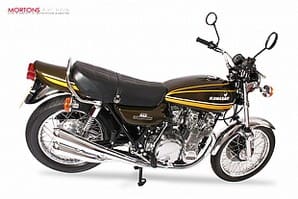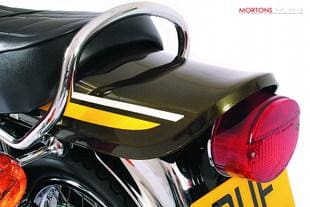
Kawasaki’s 903 Z1 is generally credited with inventing the superbike and introducing a new era of affordable, high performance, hi-tech bikes to usher in the heady days of the 70s. True, Honda’s original CB750 had gone before, heralding a sea-change in design and technology, but it was the 1972 Z1 which drew a line in the sand and challenged other manufacturers to cross it. This swaggering, arrogant motorcycle simply offered more of everything that we’d ever had before; more power, more style, more technology and more performance than almost anything else on the road; and all at a price in everyman’s reach.
While it took the biking market by storm, Kawasaki was unprepared for the demand for the new superbike and initially struggled to produce enough Z1s to meet customer demand. And though the initial model was almost perfect, one or two weaknesses became apparent as the bikes moved off the showroom floor and out into the real world of hard use. The one-piece head gasket leaked oil and had to be replaced  with a modified two-piece item with separate O ring seal for the camchain; and owners experienced problems with starter motor drives and camchain tensioners, all of which led to production line modifications. For the 1974 season Kawasaki gave the bike a cosmetic makeover, incorporated the earlier modifications and re-named the bike Z1A.
with a modified two-piece item with separate O ring seal for the camchain; and owners experienced problems with starter motor drives and camchain tensioners, all of which led to production line modifications. For the 1974 season Kawasaki gave the bike a cosmetic makeover, incorporated the earlier modifications and re-named the bike Z1A.
The biggest obvious change was the cosmetics. The original model featured a satin black finish to the crankcase castings, cylinder head and barrel, which simply refused to stay on the engine. Kawasaki lost so much money on warranty claims that the new bike had its major castings left in the raw, satin alloy finish. This proved so successful and so popular that the big Z series retained the alloy finish for the rest of the subsequent Z900 and Z1000 series, satin black only reappearing on the later Z1R and Z1000 MkII models when paint technology had moved on.
Production started
Z1A production started in 1973 and continued to mid season of 1974, when a further cosmetic revision introduced the Z1B. These three early models, Z1, Z1A and Z1B, are now considered the most collectable and desirable of the dynasty, though the final 903 Kawasaki (the 1976 Z900A4) was actually a better motorcycle in several respects, having gained from continual production line development learned from the early models. It also gained twin discs in a belated but welcome attempt to improve on the inadequate single disc system on the Z1.
By 1977 Kawasaki had lost the performance initiative, and the big Z received a capacity hike to 1015cc to remain a competitive seller, mutating into the Z1000A1. Although a fine bike in its own right, the Z1000 lost some of the Z1s flamboyant styling touches including the stylish four into four pipes, now replaced with a bland looking four into two system.
 The magic was over and the brief flame of inspiration that was the Z1 had flickered and died, but not before it had inspired a generation of die-hard followers. Z1s have always been collectable and remain high on any enthusiast’s list of desirable bikes. They were well designed, well built and durable and, while the performance is dated by modern standards, the Z1 remains one of the most thrilling bikes to ride. Spares are easily available too, even original four into four exhaust systems are now available off the shelf from specialist dealers, albeit at a price.
The magic was over and the brief flame of inspiration that was the Z1 had flickered and died, but not before it had inspired a generation of die-hard followers. Z1s have always been collectable and remain high on any enthusiast’s list of desirable bikes. They were well designed, well built and durable and, while the performance is dated by modern standards, the Z1 remains one of the most thrilling bikes to ride. Spares are easily available too, even original four into four exhaust systems are now available off the shelf from specialist dealers, albeit at a price.



